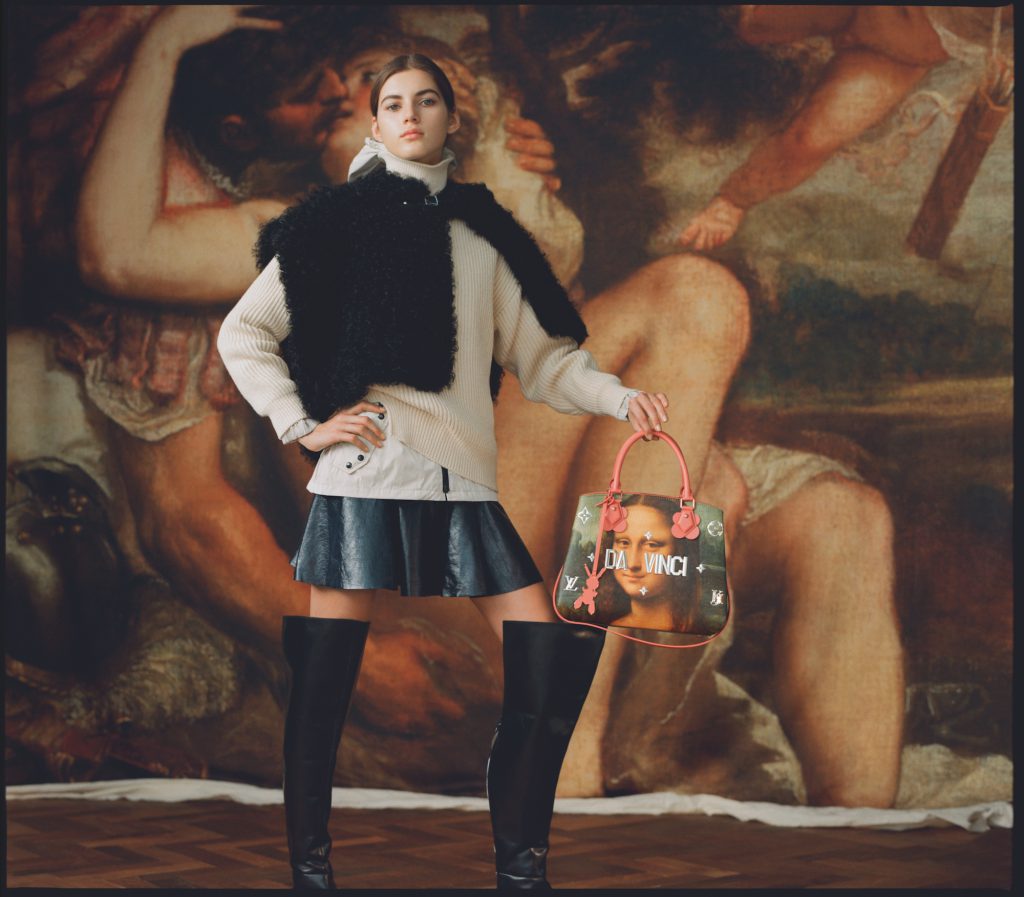Story MINH NHAT
Photos BRAND WEBSITES
Art has always played a special role in the world of fashion. It is both a statement of high-end prestige and a constant source of inspiration for designers.

Asserting status
In 2022, LVMH CEO Delphine Arnault touted the collaboration between Louis Vuitton and artist Yayoi Kusama as scripting “a new blueprint for the brand’s cultural play.” The impact was indeed eye-catching and attention-grabbing, with the artist’s signature polka dots adorning luxury fashion items and gracing a series of free exhibitions, pop-up stores, giant billboards and a digital presence that saturated social media.
By now, artist collaborations have become commonplace in the fashion industry and are more than merely fleeting affairs. Musician and rapper Pharrell Williams, for example, recently led Louis Vuitton’s menswear for a third season, signaling a strategic shift. These industry-defining partnerships have multiplied since LVMH CEO Bernard Arnault confidently positioned Louis Vuitton as not just a fashion brand but a “cultural brand,” shaping contemporary fashion dynamics. But this art-fashion hybrid did not emerge overnight. It was sparked by the ascent of haute couture in the early 20th century and by the late 1980s, fashion had entered a new realm – what critic Cathy Horyn termed “semiotic clothing”.
“Clothes suddenly acquired meaning (think of the efforts to ‘decode’ a Helmut Lang show or almost any by Martin Margiela)”, she wrote of that era in a 2014 New York Times article. “You truly needed to be an expert to appreciate why a jacket was worn inside out or why a dress that made you look like a bag lady was cool.”
Decades earlier, writer Susan Sontag noticed a similar change taking place within the art world: “The most interesting and creative art of our time is not open to the generally educated; it demands special effort; it speaks a specialized language.”
Fashion has long been inching toward such a discerning definition of art. Unlike today’s business-savvy fashion landscape, earlier eras belonged to artists driven by a fervent desire to create, as designers eagerly bridged the gap between clothing and art while further elevating luxury’s value. Like oil paintings, dresses became artifacts tied to specific historical periods, appreciated by an intellectual elite.

Fashion’s influence continues to expand, as it becomes irresistible bait for the entertainment industry. Amid this trend, “simplification” emerges as a central theme across creative endeavors. Viewing art as the fulcrum for fashion’s development and status assertion, Viktor & Rolf’s Spring/Summer 2015 collection marked their transition from ready-to-wear to a focus on haute couture. Jean-Paul Gaultier followed suit, as it seemed that protecting haute couture at all costs was the direct path to preserving the luxury legacy built since the 1980s.
A fulcrum for creativity
Haute couture remains an exclusive domain, prompting critics to reassess Demna Gvasalia after Balenciaga’s return. In light of this, how can ready-to-wear brands secure their foothold in the luxury industry? The answer lies in continuous learning, adaptation, and collaboration to navigate evolving consumer preferences and market dynamics effectively.
For fashion journalist and photographer Charlotte Cotton, the relationship between art and fashion has long been a trade-off, occurring between “the cultural superiority of art and the wide reach of fashion.”
Going beyond the initial idea of using art to inspire and express, artists creating on multiple platforms and in multiple fields is now more popular than ever.
Virgil Abloh, during his influential tenure at Louis Vuitton and with his brand, Off-White, actively broke the traditional fashion code. As Creative Director, he demonstrated that luxury menswear and streetwear need not be mutually exclusive. This rebellion were sown during Marc Jacobs’ tenure as Creative Director at Louis Vuitton (1997-2014). Jacobs, too, was a trailblazer who orchestrated high-profile collaborations with artists like Jeff Koons and Richard Prince.

In 2003, Jacobs collaborated with superstar artist Takashi Murakami, resulting in the iconic “rainbow” monogram system adorning signature leather goods. In 2006, he forged a lasting partnership with Yayoi Kusama. And in 2007, Takashi Murakami held a solo exhibition at the Los Angeles Museum of Contemporary Art, centered around the “superflat” creative philosophy that finds bridges between handbag design and painting with shared cultural values.
In March 2024, Dior collaborated with Vietnamese contemporary artists Tia-Thuy Nguyen and Bui Cong Khanh to showcase the Lady Dior bag in Ho Chi Minh City, showcasing the interplay between art and fashion. Concurrently, legendary designers like Alexander McQueen, Rei Kawakubo, and Vivienne Westwood have left their own marks on the contemporary art scene.
Current educators, meanwhile, are pushing the next generation of designers to develop their creativity before starting to look at fashion with a business eye. As Xavier Romatet, dean of Institut Français de la Mode wrote in his open letter for a recruitment campaign in January 2024: “Creativity and pure art will always serve as the driving force behind fashion.”










